Gemini wrld
Welcome to gemini world, welcome to my world of infinite knowledge and possibilities.
- 491
- 0
- 31
Community
- Followers
- Following
523 items

BIOD 121 - Essentials in Nutrition Module 1
What is nutrition: - nutrition by definition is a science that links food to health and disease. It includes the processes that humans ingest, digest, absorb, transport, and excrete substances Nutrition spands all ages in which: - it impacts the time of birth to the time of death How do pharmaceuticals and the food industry play into nutrition: - through the different supplements we take, what we eat and why we eat as far as food safety, mass production, restaurants, manufacturers, media, ...
- Exam (elaborations)
- • 9 pages •
What is nutrition: - nutrition by definition is a science that links food to health and disease. It includes the processes that humans ingest, digest, absorb, transport, and excrete substances Nutrition spands all ages in which: - it impacts the time of birth to the time of death How do pharmaceuticals and the food industry play into nutrition: - through the different supplements we take, what we eat and why we eat as far as food safety, mass production, restaurants, manufacturers, media, ...
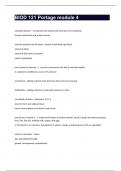
BIOD 121 Portage module 4
essential vitamins - 13 vitamins that animal cells need but can't synthesize found in both plant and animal sources vitamins produced by the body - vitamin K and biotin (gut flora) vitamin D (skin) vitamin A (from beta carotene) niacin (tryptophan) two criteria for vitamins - 1. must be consumed in the diet to maintain health. 2. symptoms of deficiency occur in its absence enrichment - adding nutrients back that have been lost to processing fortification - adding nutrient not ...
- Summary
- • 8 pages •
essential vitamins - 13 vitamins that animal cells need but can't synthesize found in both plant and animal sources vitamins produced by the body - vitamin K and biotin (gut flora) vitamin D (skin) vitamin A (from beta carotene) niacin (tryptophan) two criteria for vitamins - 1. must be consumed in the diet to maintain health. 2. symptoms of deficiency occur in its absence enrichment - adding nutrients back that have been lost to processing fortification - adding nutrient not ...

BIOD 121 (Portage): Module 1
What is nutrition? - Nutrition by definition is the science that links foods to health and disease. When is nutrition important? - from conception to death When considering one's health, five dimensions can be evaluated: physical health, intellectual health, emotional health, social health, and spiritual health. - physical health - body's ability to perform daily functions for survival intellectual health - the cognitive ability to learn and adapt emotional health - the ability to expr...
- Exam (elaborations)
- • 10 pages •
What is nutrition? - Nutrition by definition is the science that links foods to health and disease. When is nutrition important? - from conception to death When considering one's health, five dimensions can be evaluated: physical health, intellectual health, emotional health, social health, and spiritual health. - physical health - body's ability to perform daily functions for survival intellectual health - the cognitive ability to learn and adapt emotional health - the ability to expr...
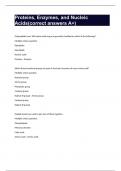
IB Biology Unit 3: Proteins, Enzymes, and Nucleic Acid
IB Biology Unit 3: Proteins, Enzymes, and Nucleic Acid
- Package deal
- • 3 items •
- IB Biology Unit 3: Proteins, Enzymes, and Nucleic Acids • Exam (elaborations)
- Proteins, Enzymes, and Nucleic Acids • Summary
- Proteins, Enzymes, and Nucleic Acids • Exam (elaborations)
IB Biology Unit 3: Proteins, Enzymes, and Nucleic Acid
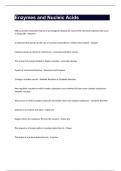
Enzymes and Nucleic Acids
RNA or protein molecules that serve as biological catalysts for most of the chemical reactions that occur in living cells - Enzymes A molecule that speeds up the rate of reactions (sometimes 1 million times faster) - Catalyst Catalysts speed up chemical reactions by - Lowering activation energy The amount of energy needed to begin a reaction - Activation Energy 2 parts of a Chemical Reaction - Reactants and Products 2 things a reaction can do - Anabolic Reaction or Catabolic React...
- Exam (elaborations)
- • 4 pages •
RNA or protein molecules that serve as biological catalysts for most of the chemical reactions that occur in living cells - Enzymes A molecule that speeds up the rate of reactions (sometimes 1 million times faster) - Catalyst Catalysts speed up chemical reactions by - Lowering activation energy The amount of energy needed to begin a reaction - Activation Energy 2 parts of a Chemical Reaction - Reactants and Products 2 things a reaction can do - Anabolic Reaction or Catabolic React...
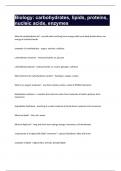
biology: carbohydrates, lipids, proteins, nucleic acids, enzymes
What do carbohydrates do? - provide short and long term energy which your body breaks down, use energy of chemical bonds examples of carbohydrates - sugars, starches, cellulose carbohydrate monomer - monosaccharide, ex. glucose carbohydrate polymer - polysaccharide, ex. starch, glycogen, cellulose What elements do carbohydrates contain? - hydrogen, oxygen, carbon What is an organic molecule? - one that contains carbon, made of SPONCH elements dehydration synthesis - a reaction ...
- Exam (elaborations)
- • 4 pages •
What do carbohydrates do? - provide short and long term energy which your body breaks down, use energy of chemical bonds examples of carbohydrates - sugars, starches, cellulose carbohydrate monomer - monosaccharide, ex. glucose carbohydrate polymer - polysaccharide, ex. starch, glycogen, cellulose What elements do carbohydrates contain? - hydrogen, oxygen, carbon What is an organic molecule? - one that contains carbon, made of SPONCH elements dehydration synthesis - a reaction ...

Proteins, Enzymes, and Nucleic Acids
Polypeptides over 100 amino acids long are generally classified as which of the following? Multiple choice question. Dipeptides Glycolipids Nucleic acids Proteins - Proteins Which three functional groups are part of the basic structure of every amino acid? Multiple select question. Hydroxyl group Amino group Phosphate group Carboxyl group Radical (R group) - Amino group Carboxyl group Radical (R group) Peptide bonds are used to join two of these together. Multiple choice ques...
- Package deal
- Exam (elaborations)
- • 15 pages •
Polypeptides over 100 amino acids long are generally classified as which of the following? Multiple choice question. Dipeptides Glycolipids Nucleic acids Proteins - Proteins Which three functional groups are part of the basic structure of every amino acid? Multiple select question. Hydroxyl group Amino group Phosphate group Carboxyl group Radical (R group) - Amino group Carboxyl group Radical (R group) Peptide bonds are used to join two of these together. Multiple choice ques...

Proteins, Enzymes, and Nucleic Acids
Amino Acids - The building blocks of proteins. Amino Acids - Contain a carboxylic acid group and and an amino acid group on the alpha carbon. Amino Acids - are ionized in solution. Amino Acids - Each contain a different side group (R). Nonpolar - Hydrocarbon side chains (hydrophobic) Polar (neutral) - Polar or ionic side chains (hydrophilic) Polar (acidic) - Acidic side chains (hydrophilic) Polar (basic) - -NH2 side chains (hydrophilic) H, an alkyl group, or aromatic - A ...
- Package deal
- Summary
- • 15 pages •
Amino Acids - The building blocks of proteins. Amino Acids - Contain a carboxylic acid group and and an amino acid group on the alpha carbon. Amino Acids - are ionized in solution. Amino Acids - Each contain a different side group (R). Nonpolar - Hydrocarbon side chains (hydrophobic) Polar (neutral) - Polar or ionic side chains (hydrophilic) Polar (acidic) - Acidic side chains (hydrophilic) Polar (basic) - -NH2 side chains (hydrophilic) H, an alkyl group, or aromatic - A ...
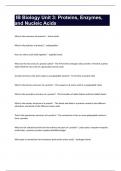
IB Biology Unit 3: Proteins, Enzymes, and Nucleic Acids
What is the monomer of proteins? - Amino Acids What is the polymer of proteins? - polypeptides How are amino acids held together? - peptide bonds What are the two ends of a protein called? - The N-Terminis (nitrogen side) and the C-Terminis (carbon side) (Think the two ends of a generalized amino acid) At what terminis is the start codon of a polypeptide located? - N-Terminis (contains Met) What is the primary structure of a protein? - The sequence of amino acids in a polypeptide ...
- Package deal
- Exam (elaborations)
- • 10 pages •
What is the monomer of proteins? - Amino Acids What is the polymer of proteins? - polypeptides How are amino acids held together? - peptide bonds What are the two ends of a protein called? - The N-Terminis (nitrogen side) and the C-Terminis (carbon side) (Think the two ends of a generalized amino acid) At what terminis is the start codon of a polypeptide located? - N-Terminis (contains Met) What is the primary structure of a protein? - The sequence of amino acids in a polypeptide ...

Maternal and Child Health Nursing Practice Quiz
Which behaviors would be exhibited during the letting-go phase of maternal role adaptation. Select all that apply. - Emergence of family unit Sexual intimacy relationship continuing Defining one's individual roles While making a visit to the home of a postpartum woman 1 week after birth, the nurse should recognize that the woman would characteristically: - Vacillate between the desire to have her own nurturing needs met and the need to take charge of her own care and that of her newborn. ...
- Exam (elaborations)
- • 19 pages •
Which behaviors would be exhibited during the letting-go phase of maternal role adaptation. Select all that apply. - Emergence of family unit Sexual intimacy relationship continuing Defining one's individual roles While making a visit to the home of a postpartum woman 1 week after birth, the nurse should recognize that the woman would characteristically: - Vacillate between the desire to have her own nurturing needs met and the need to take charge of her own care and that of her newborn. ...
